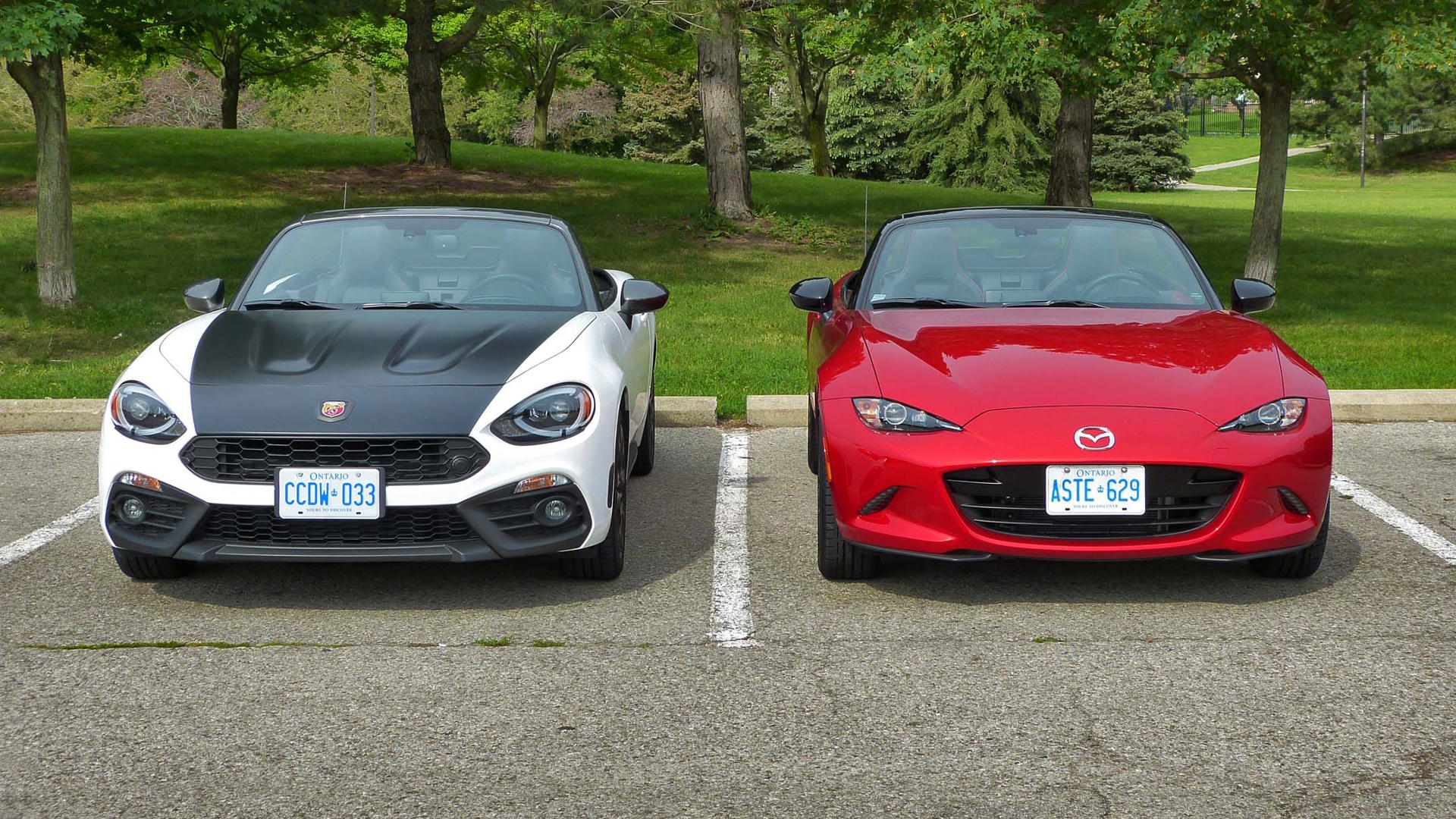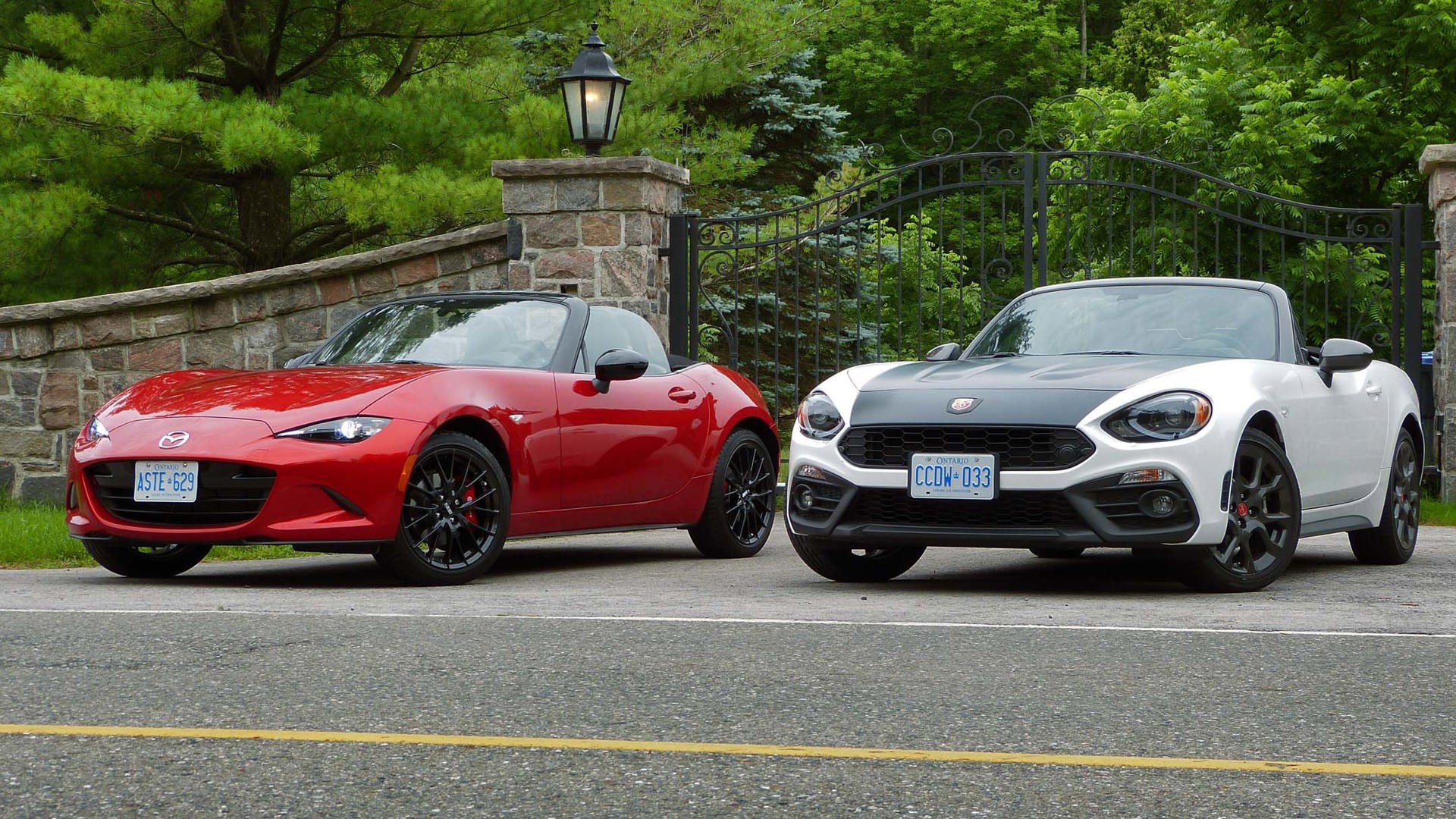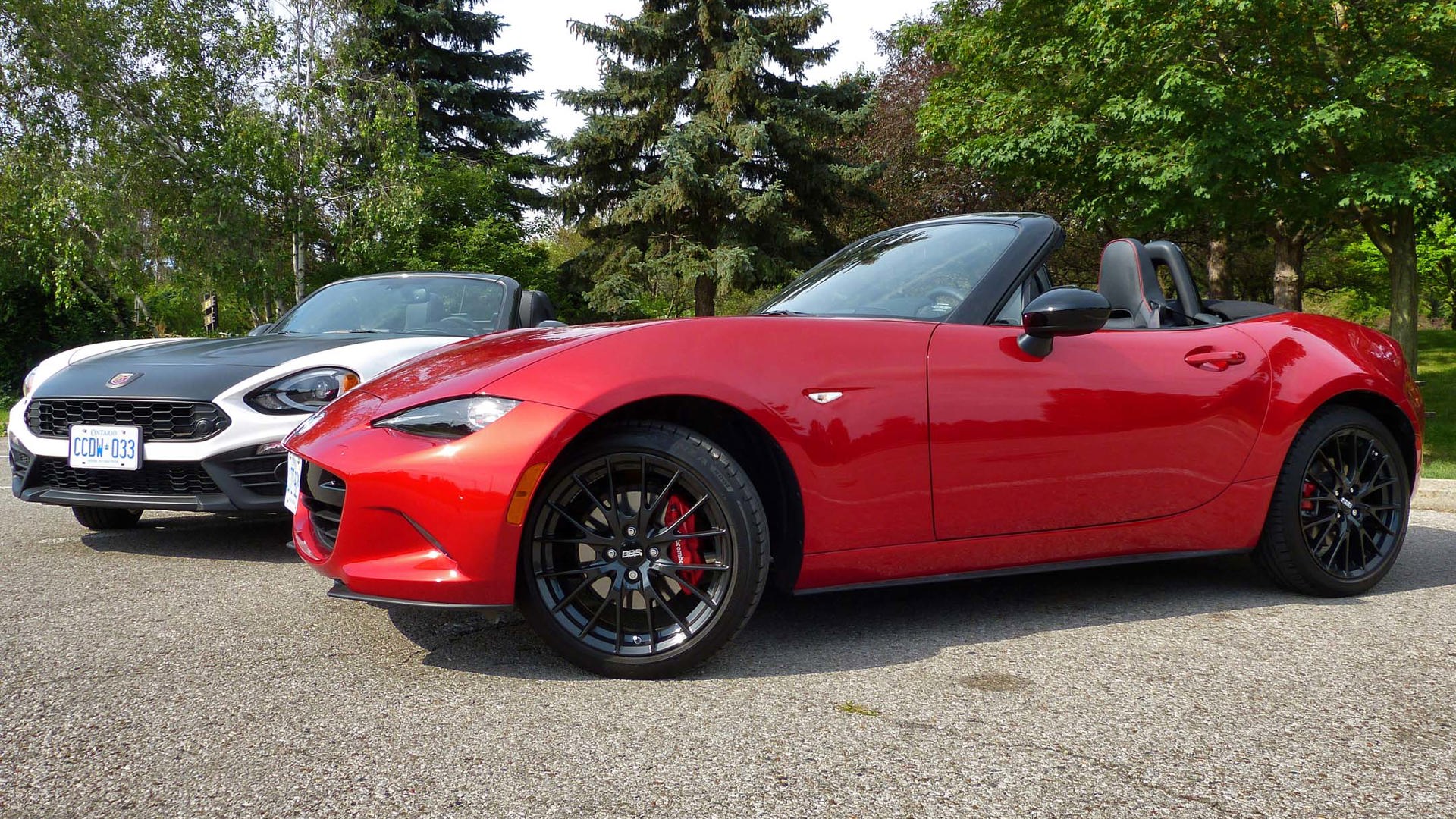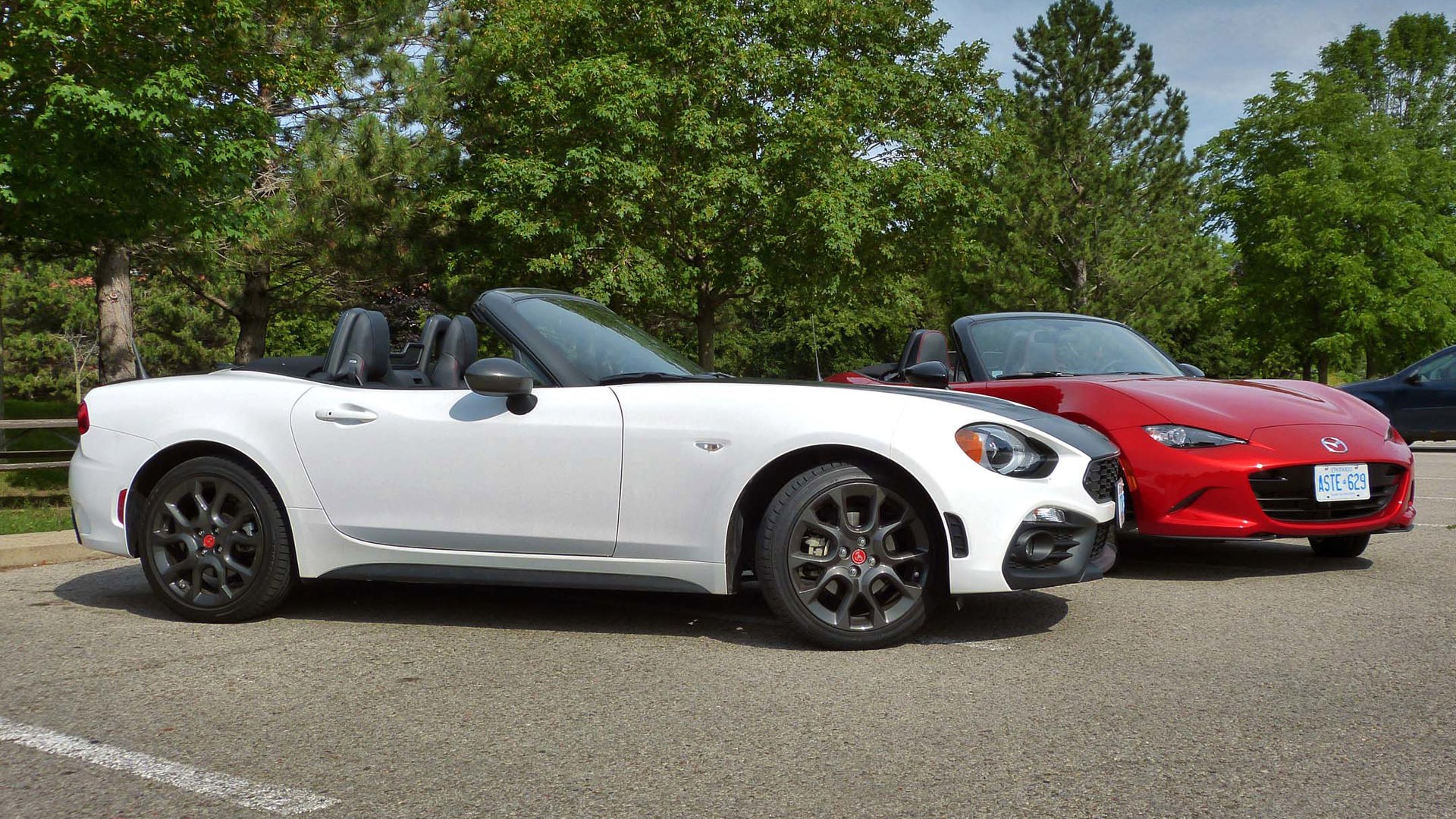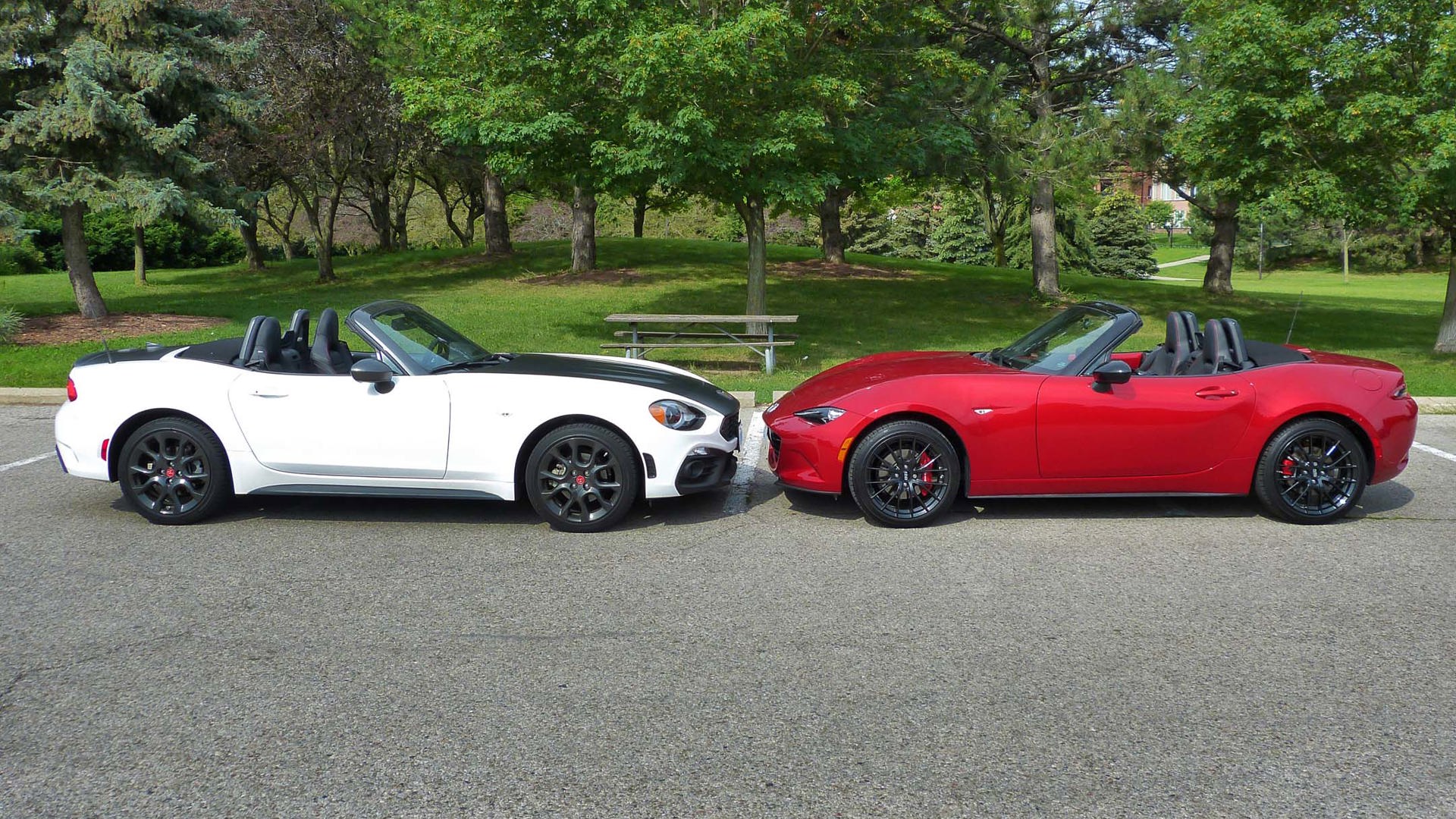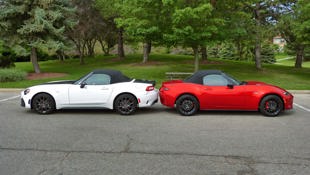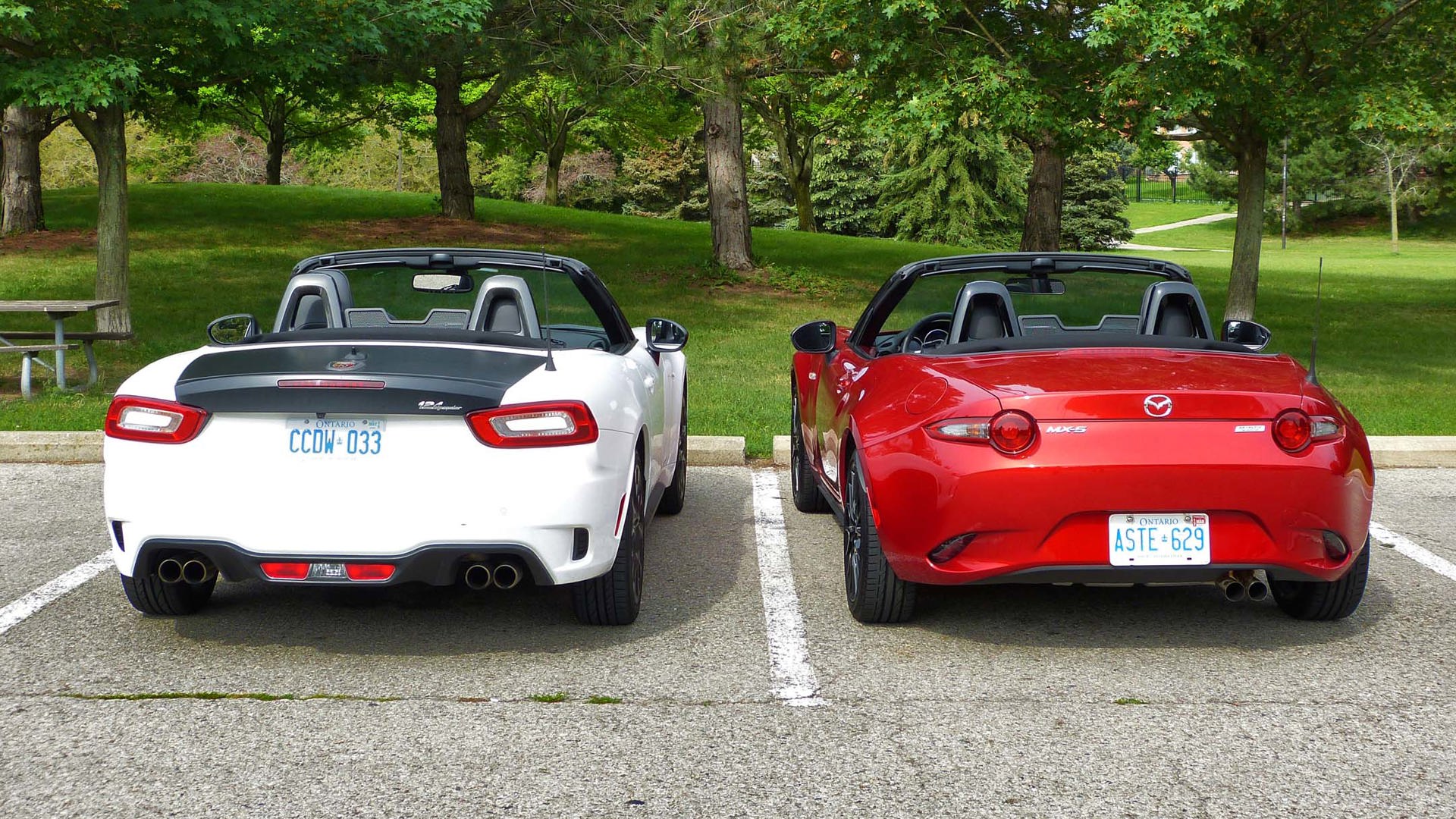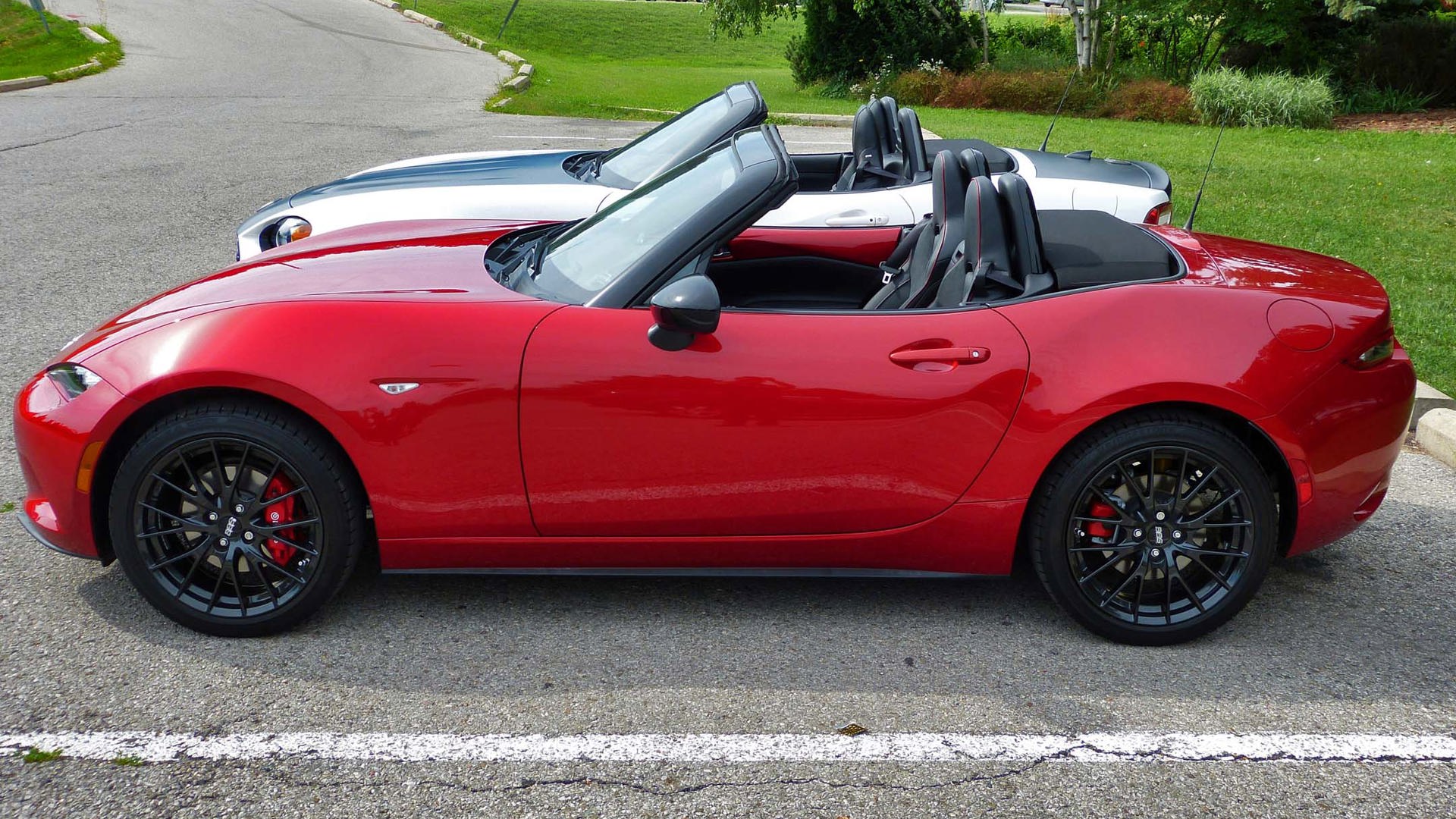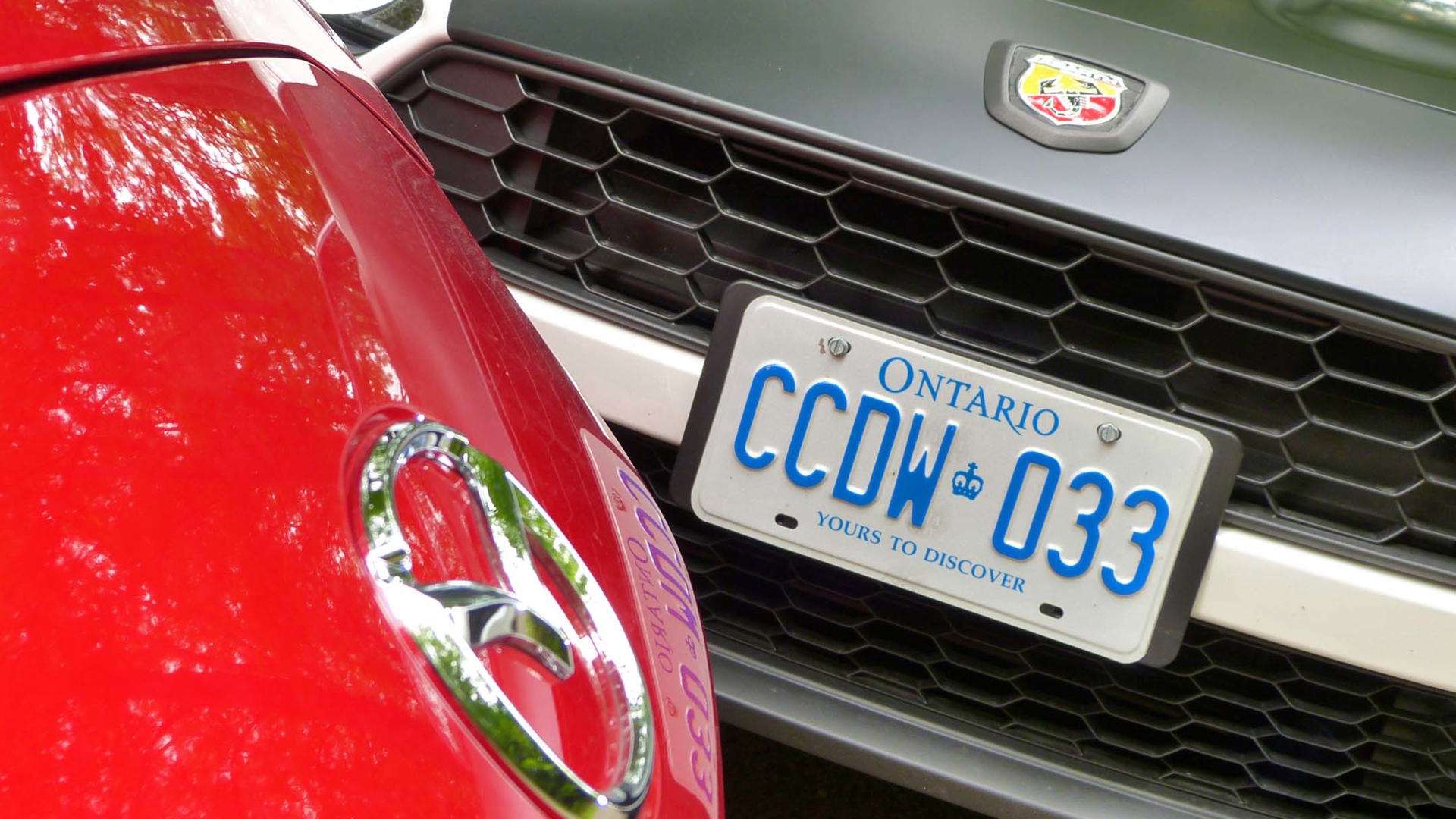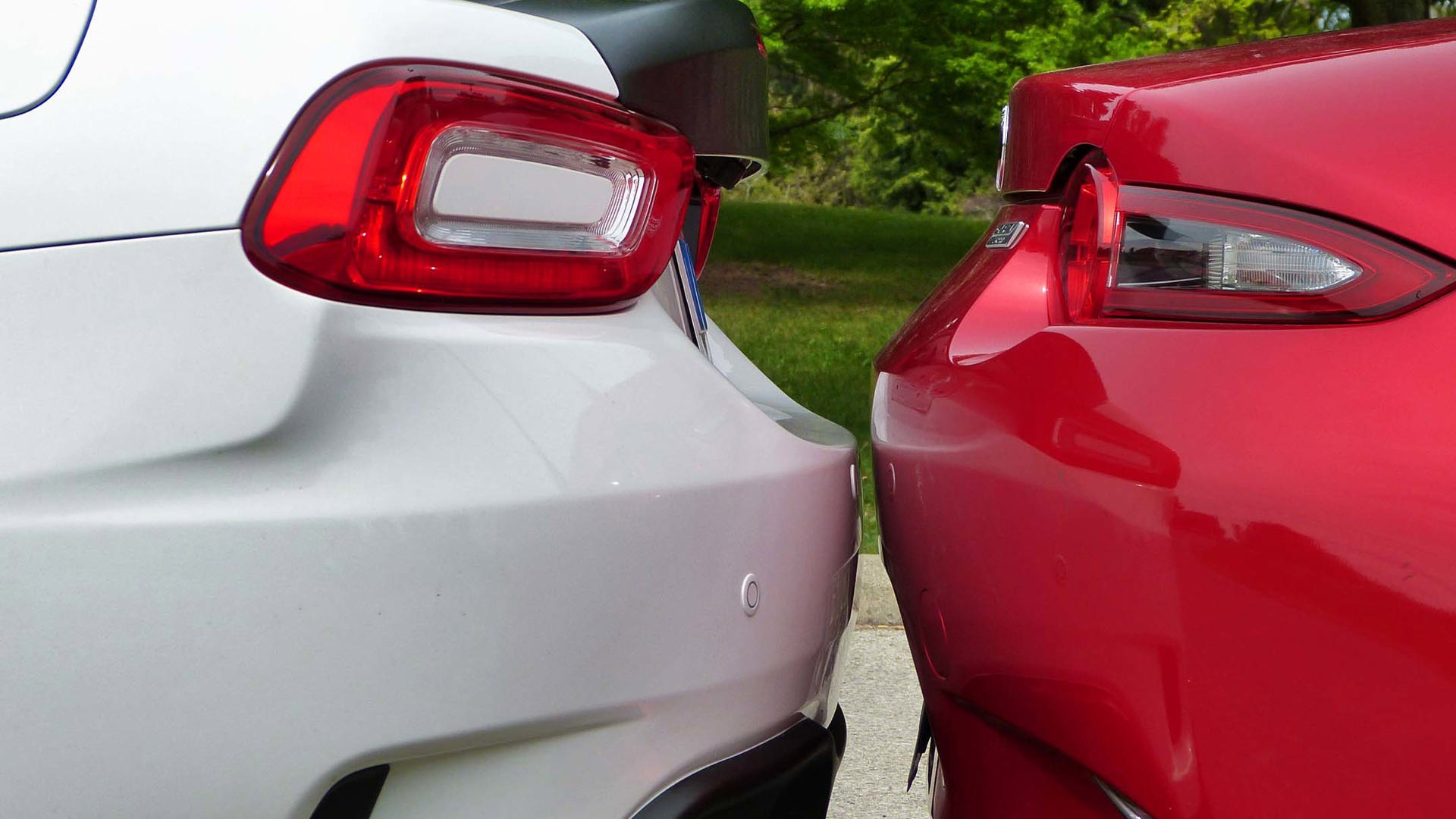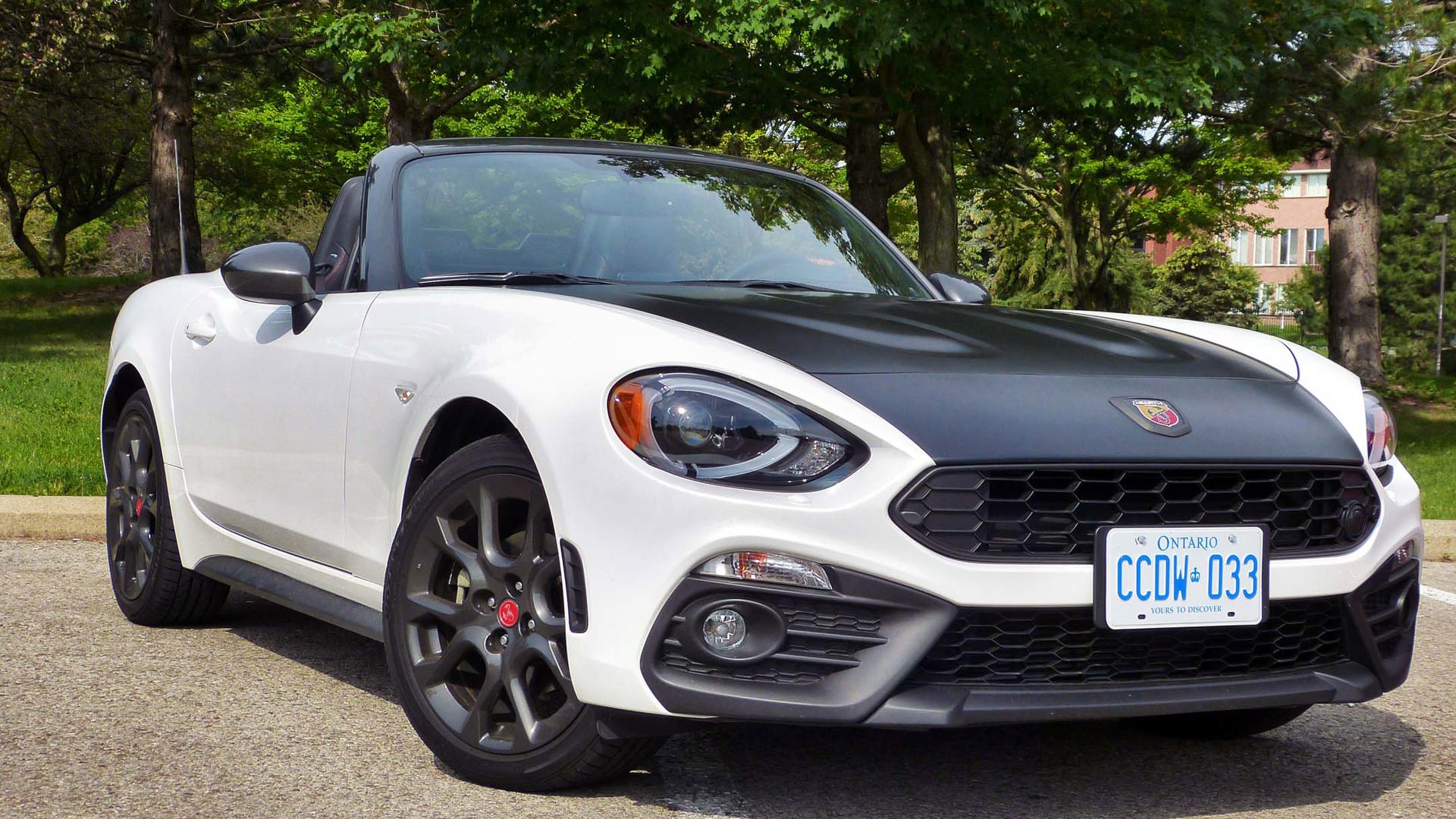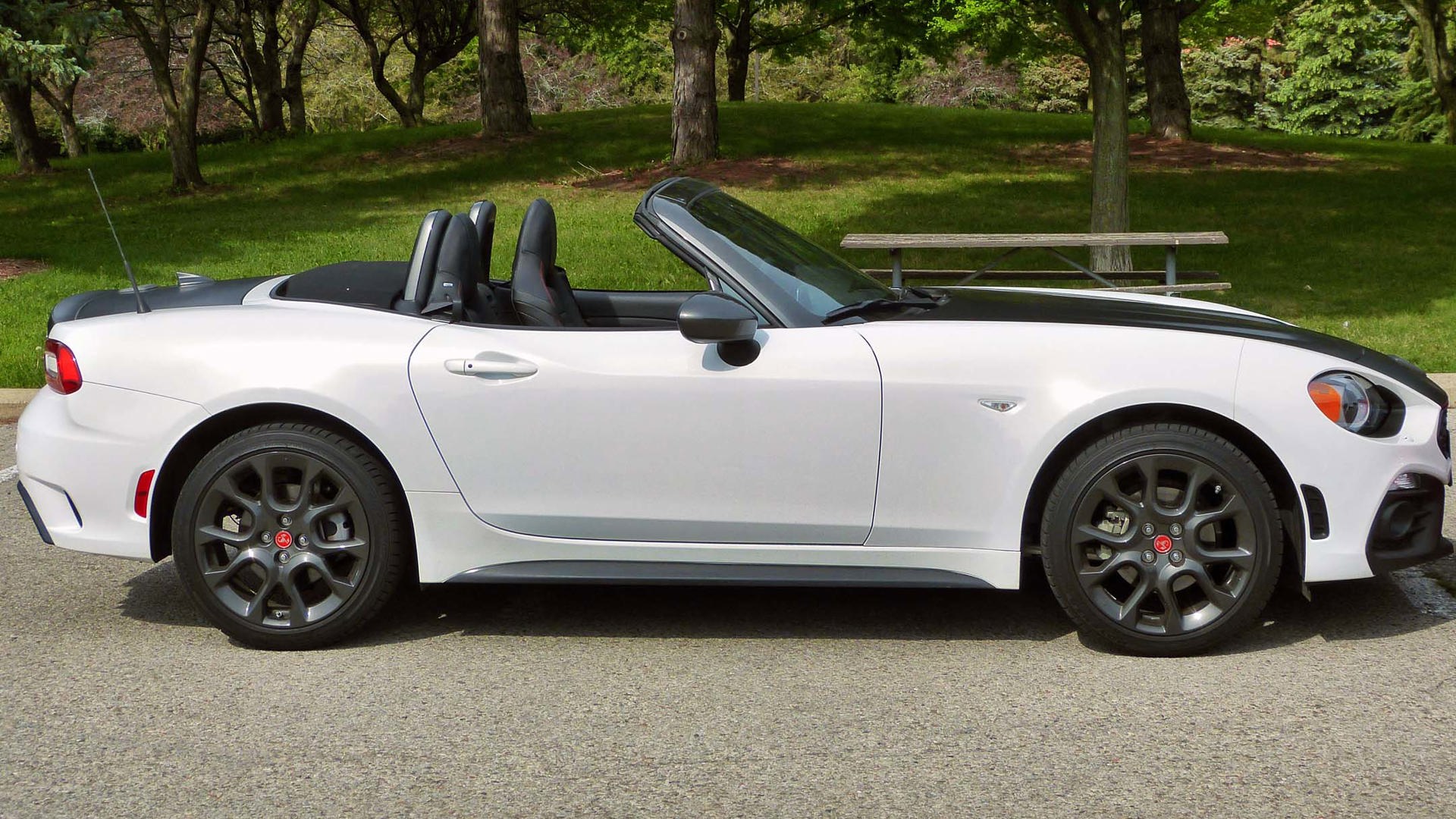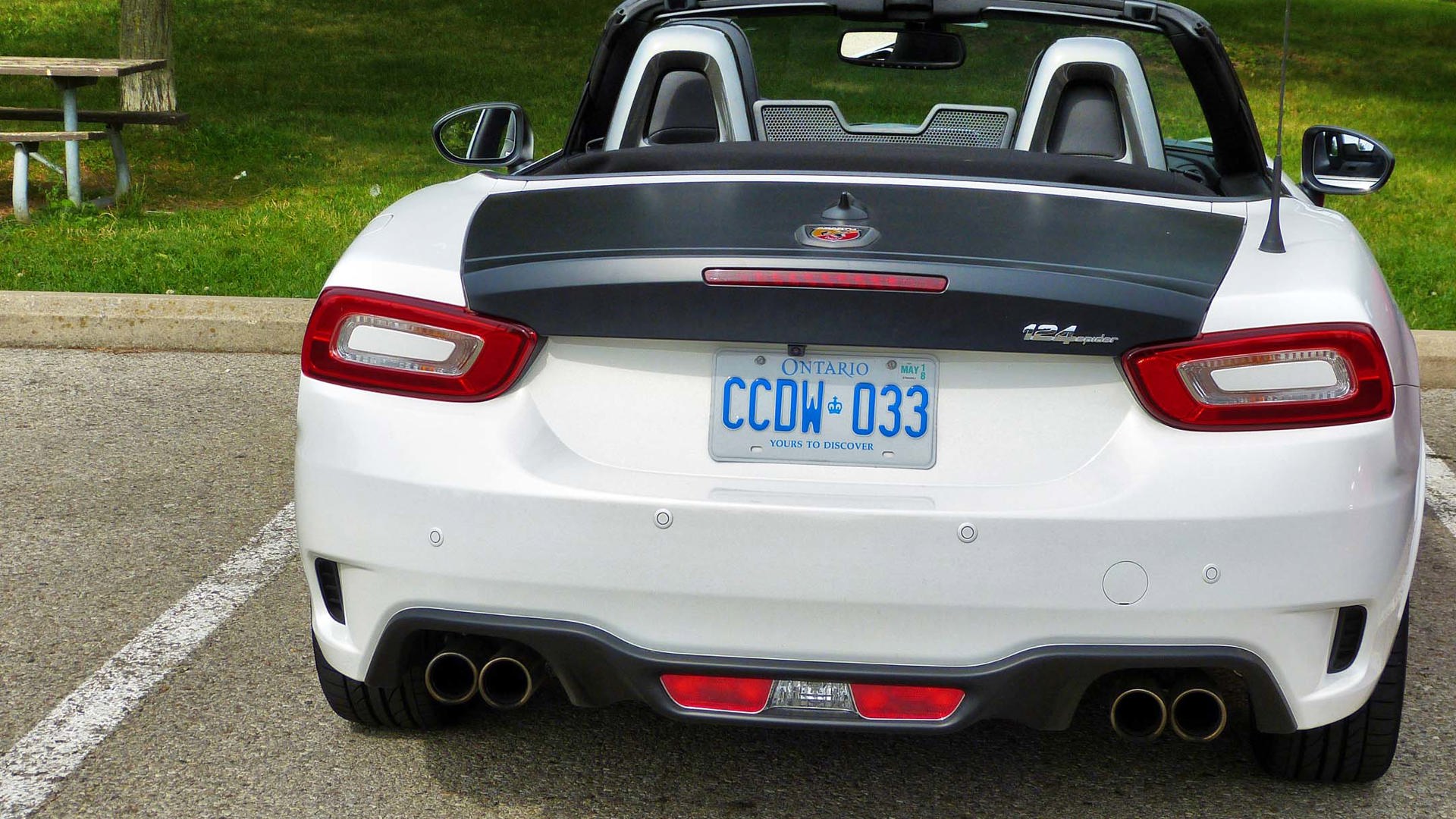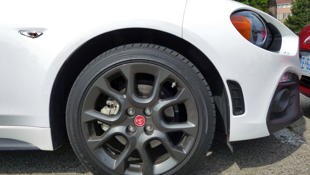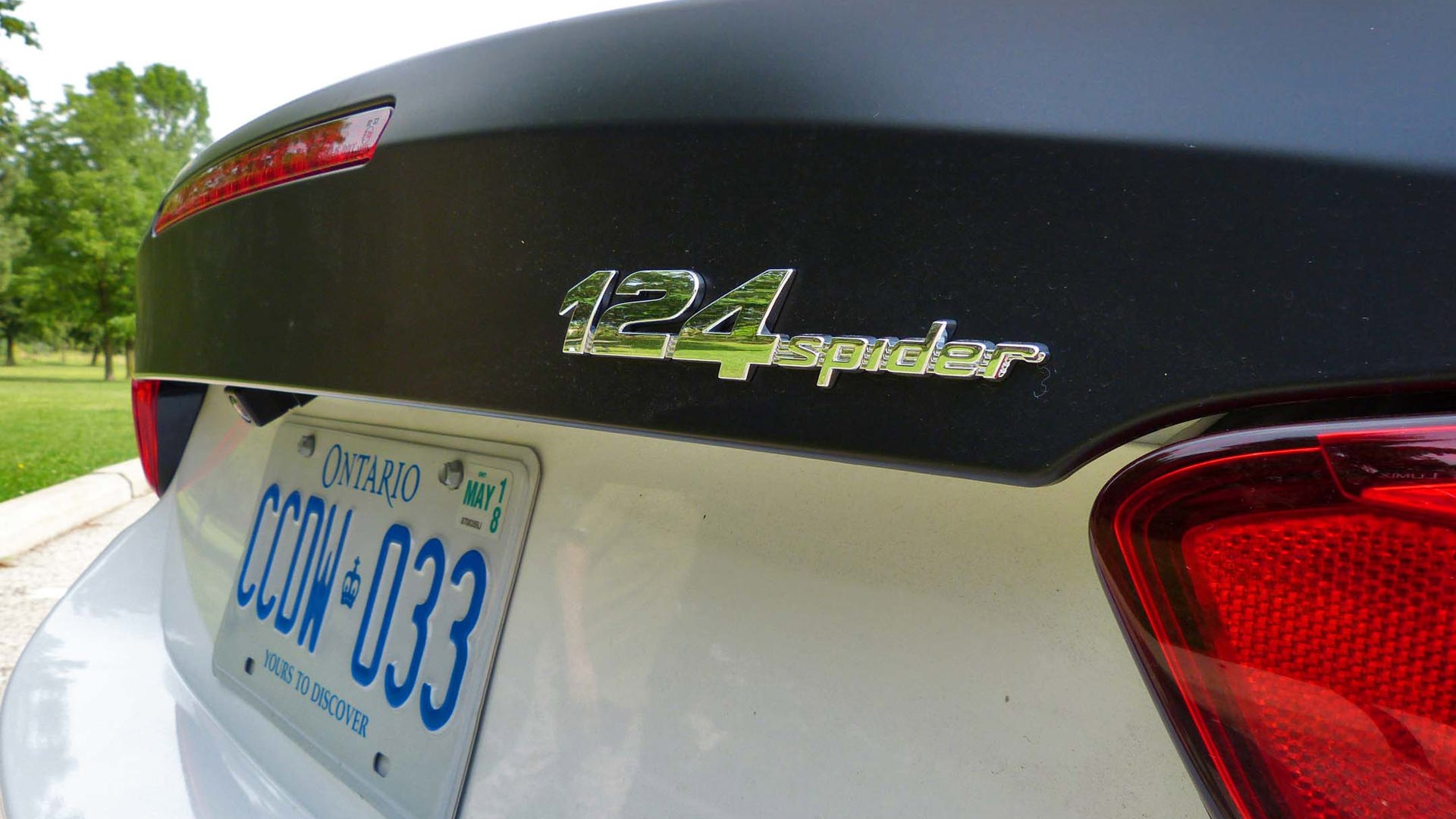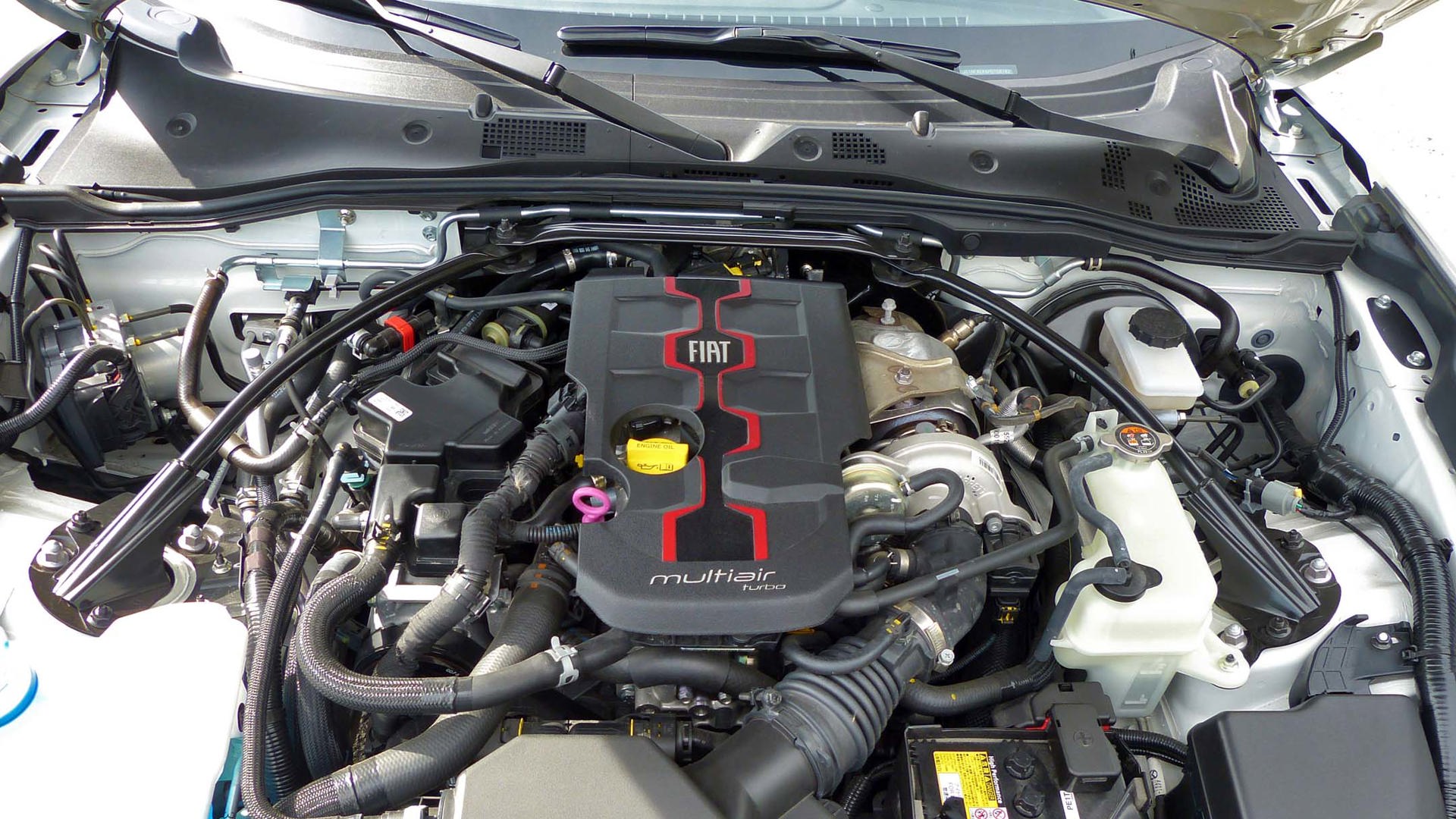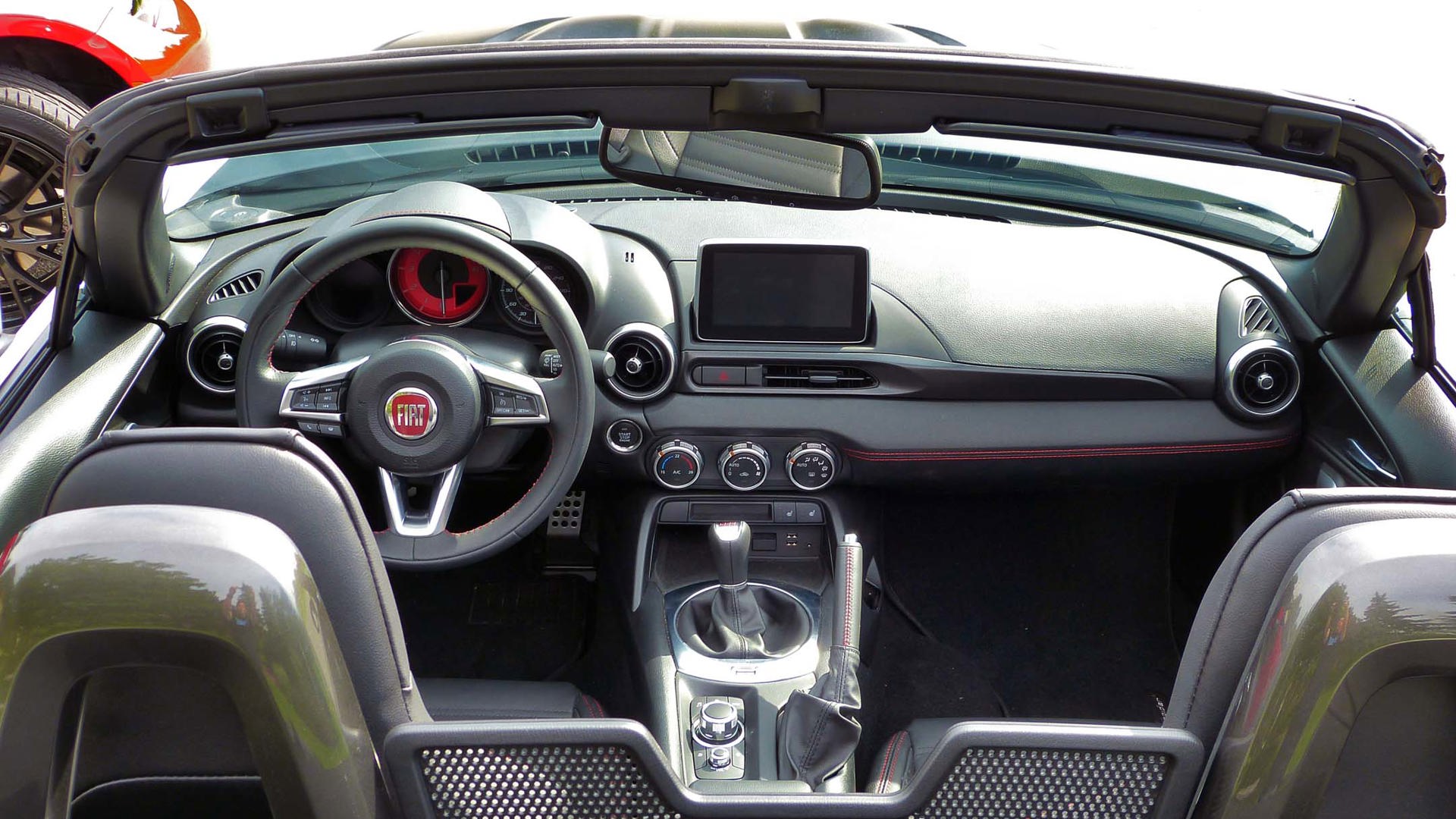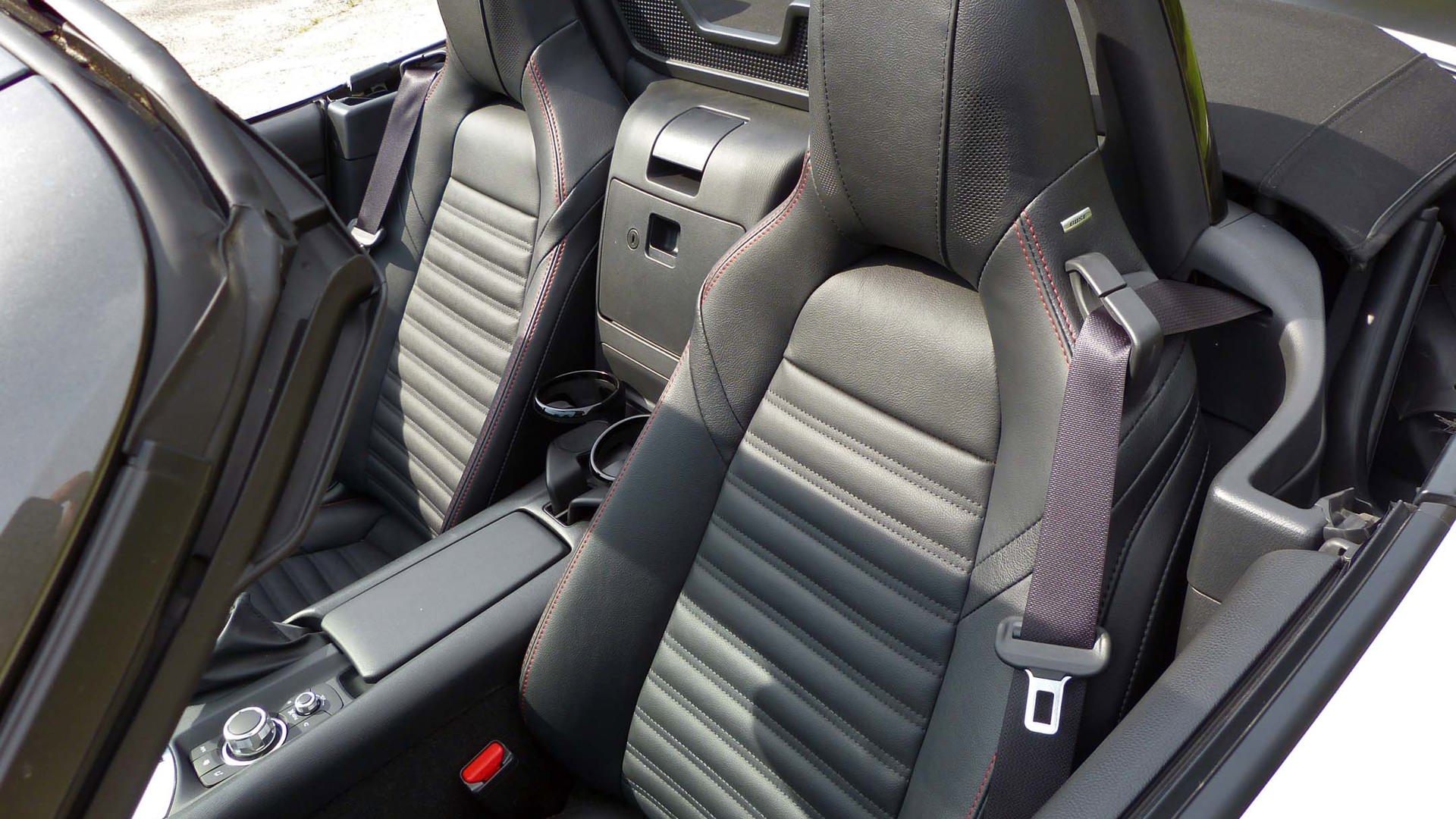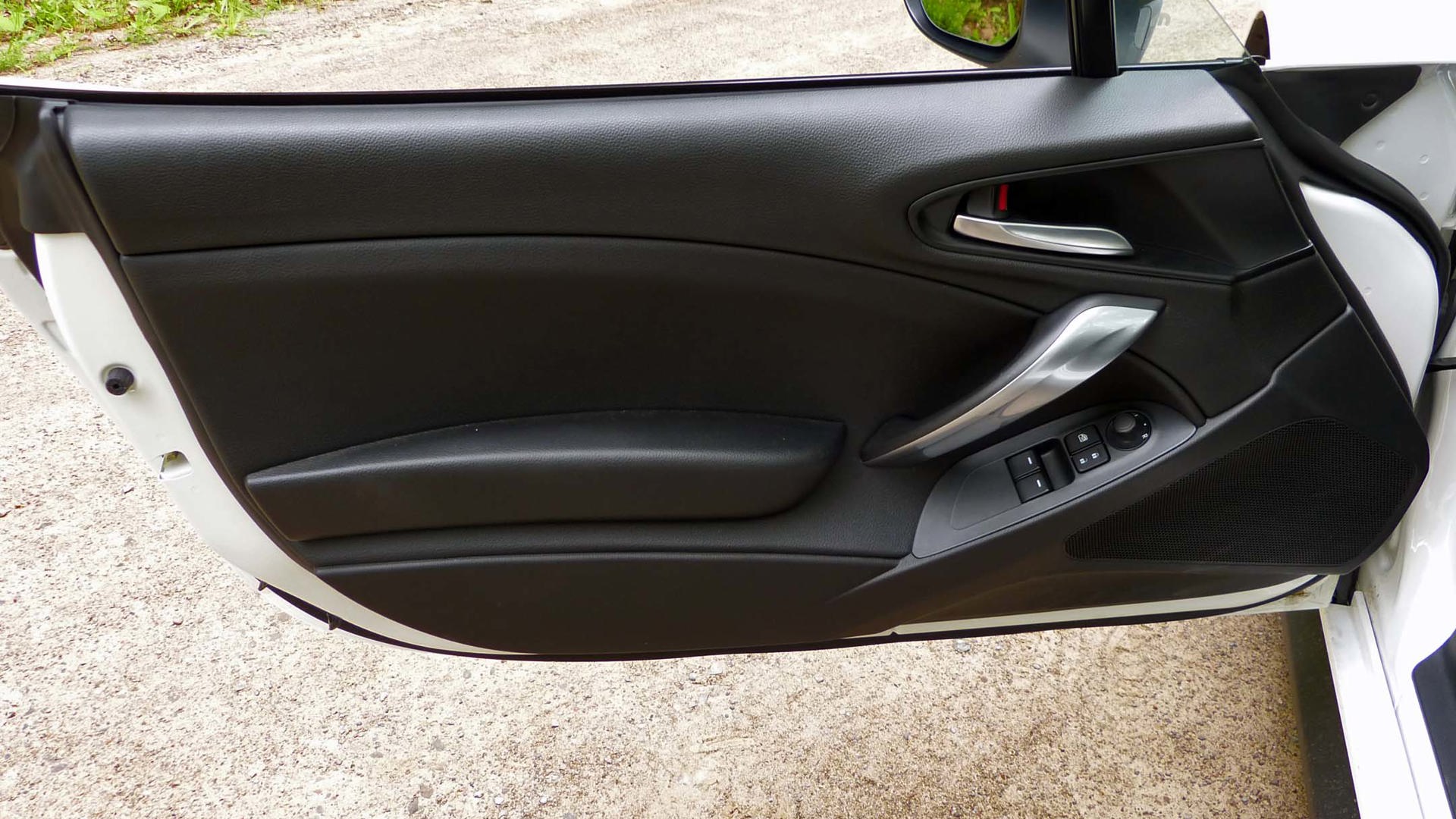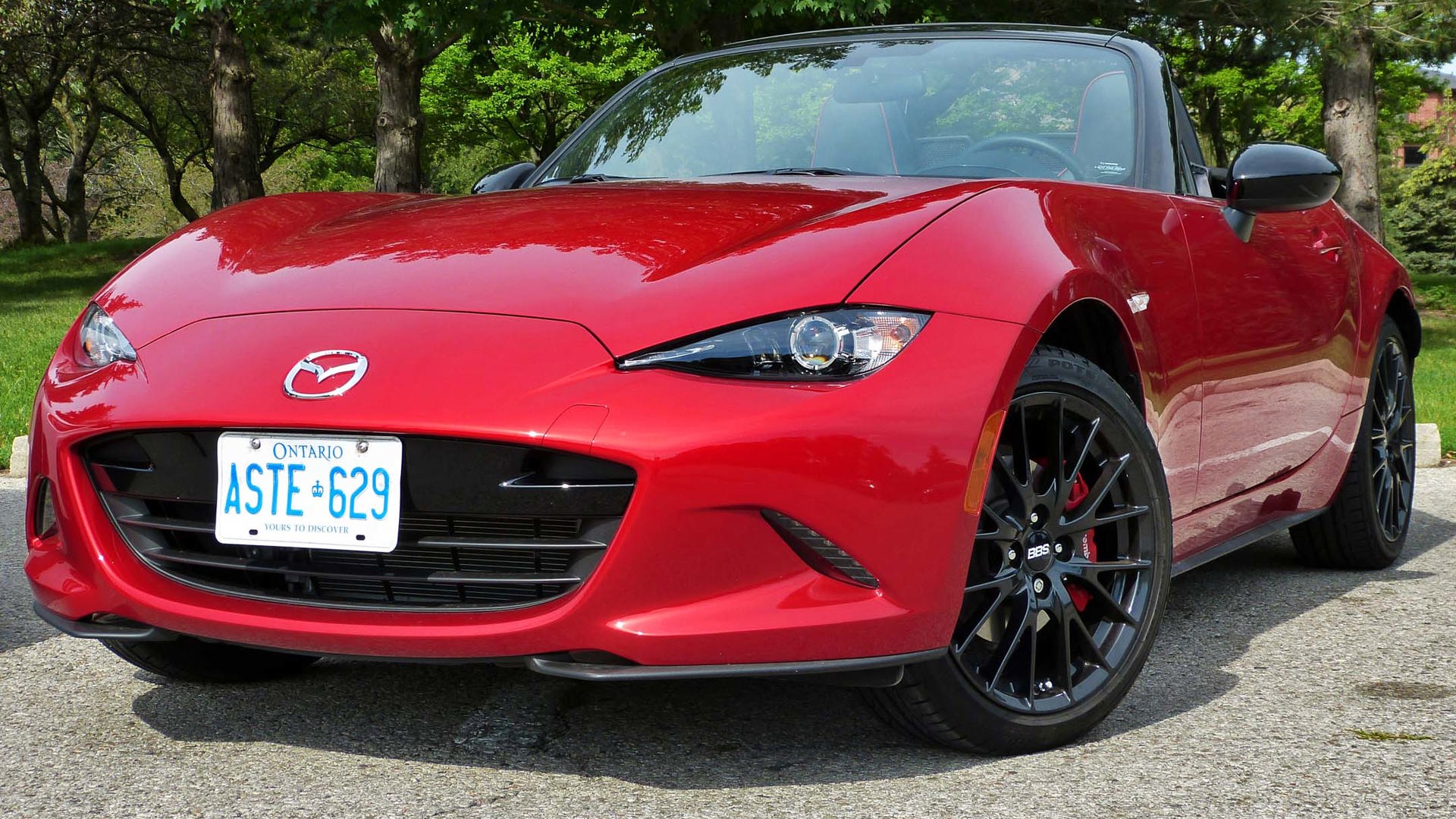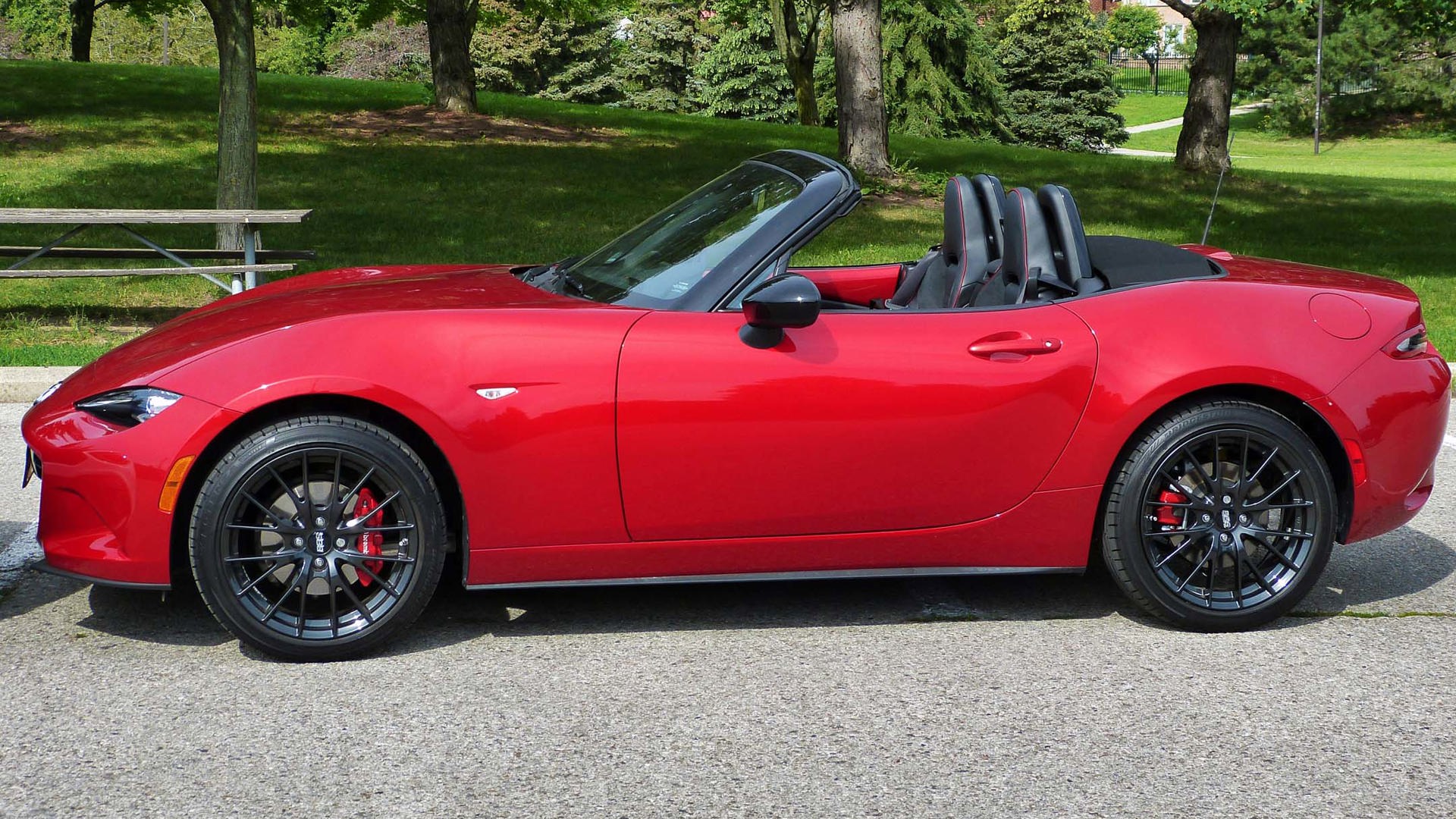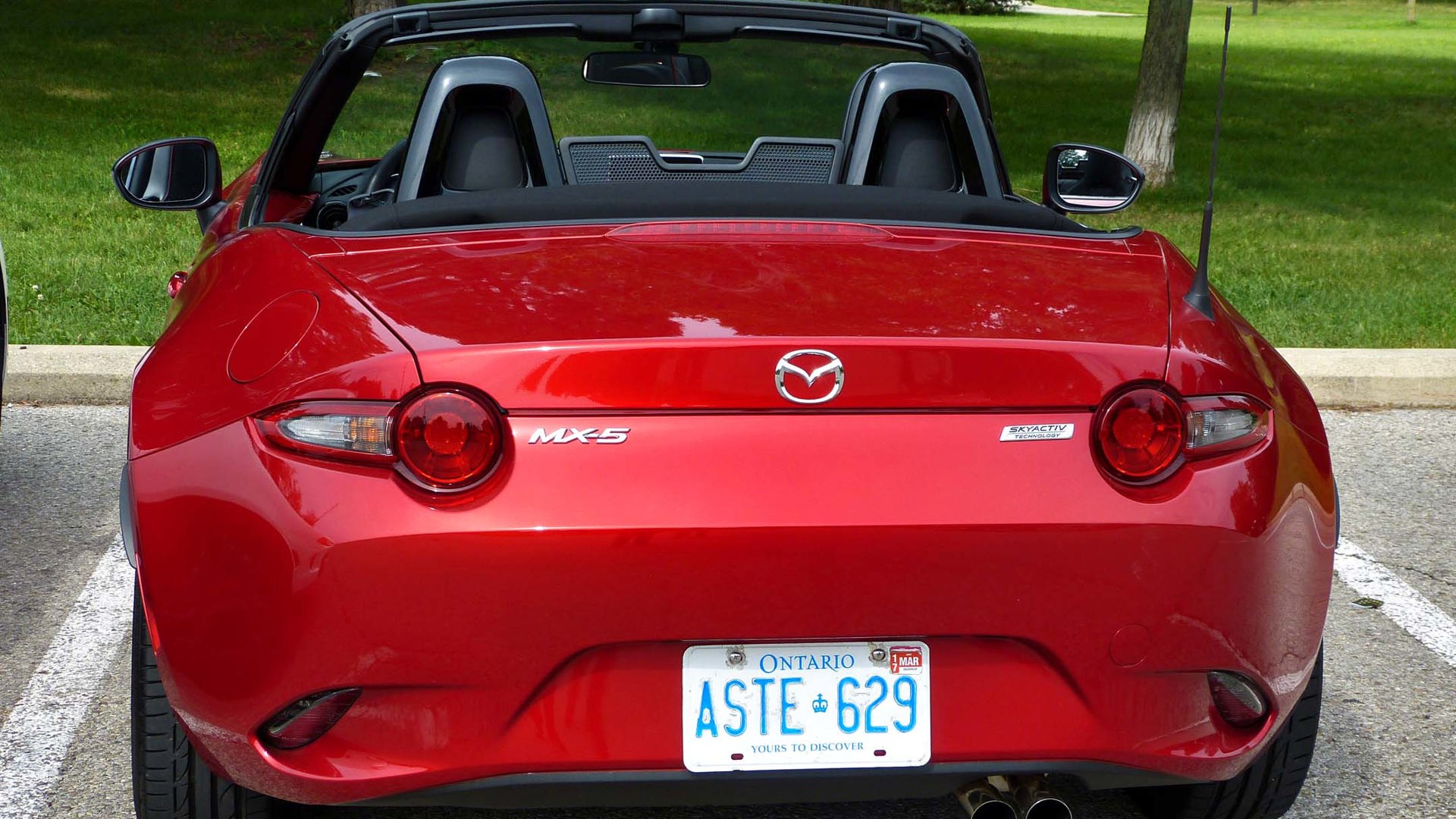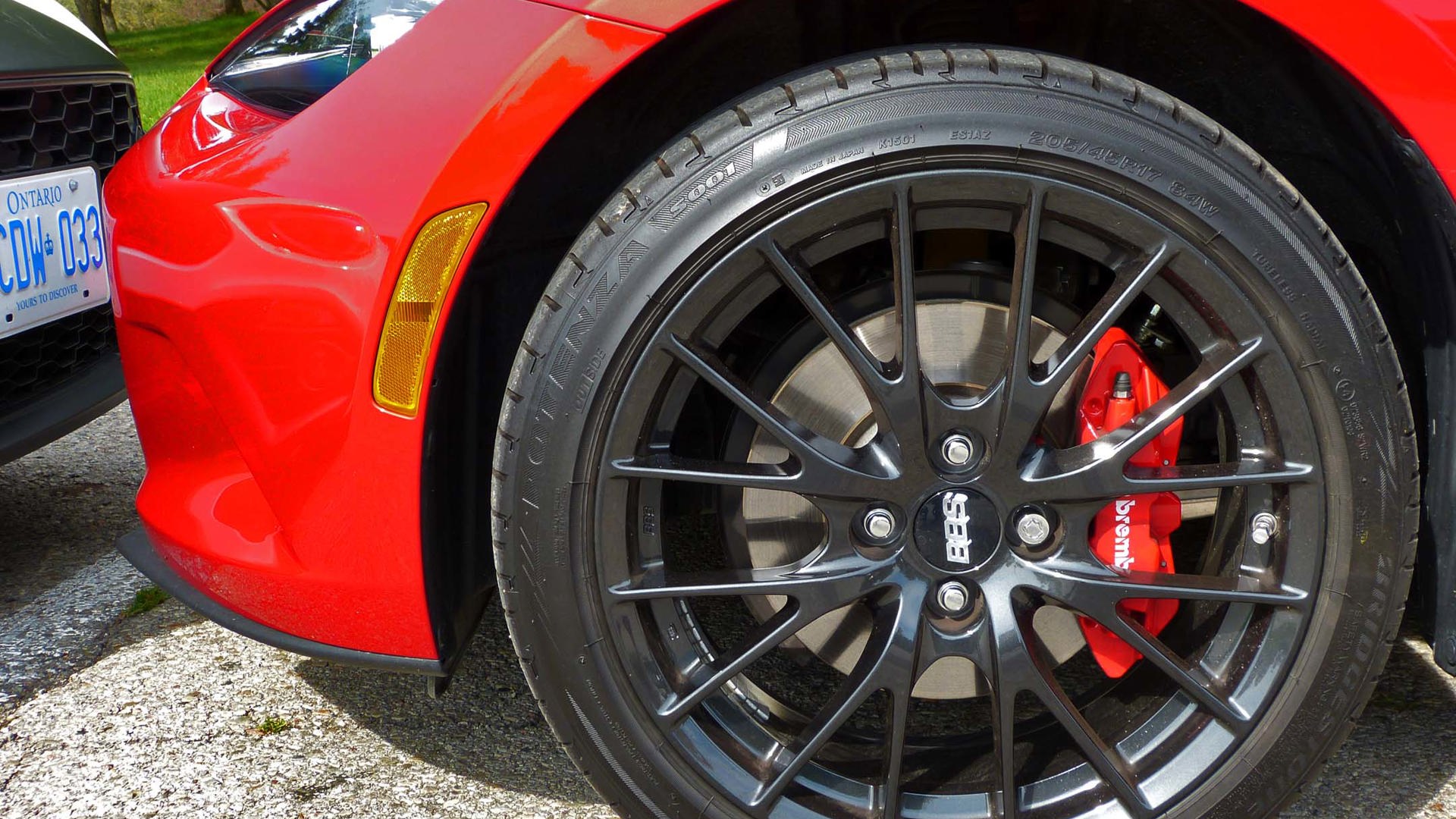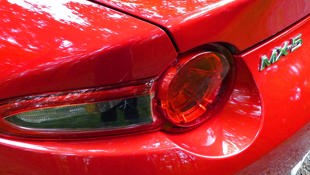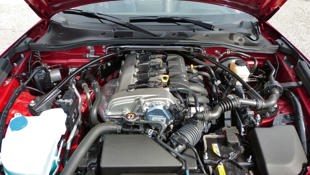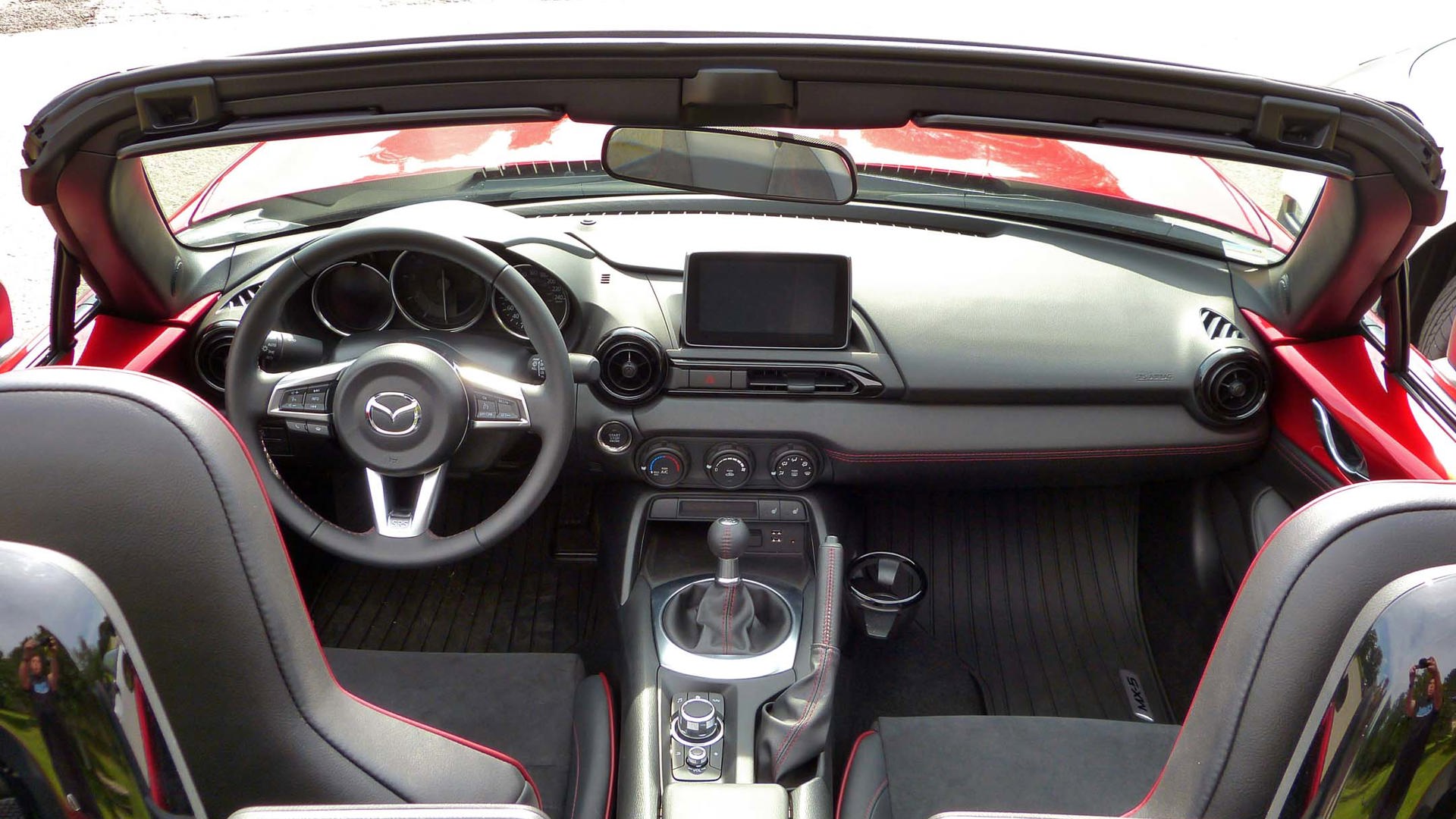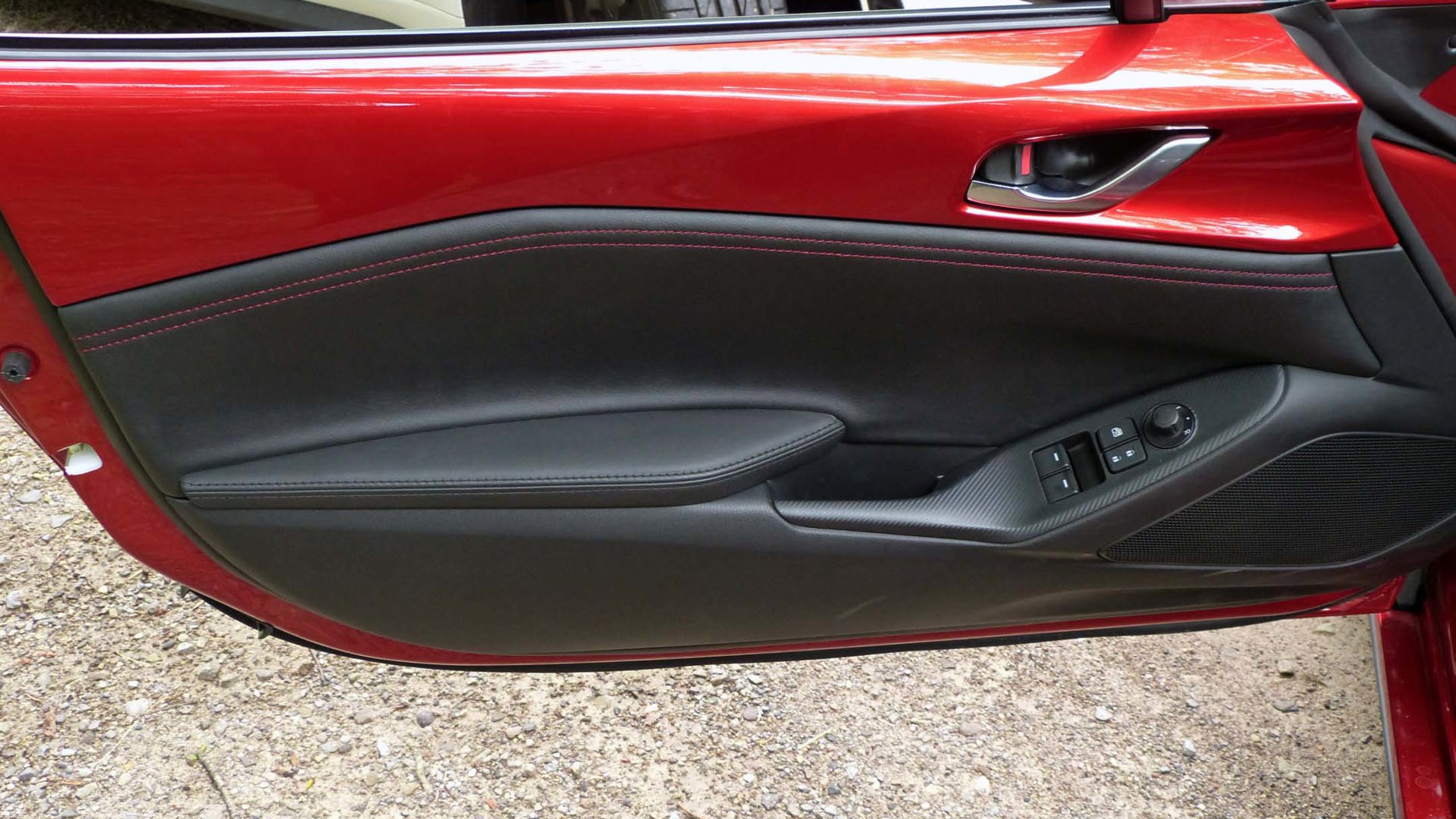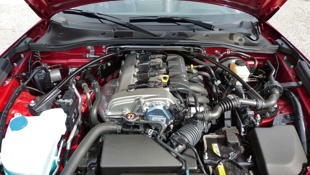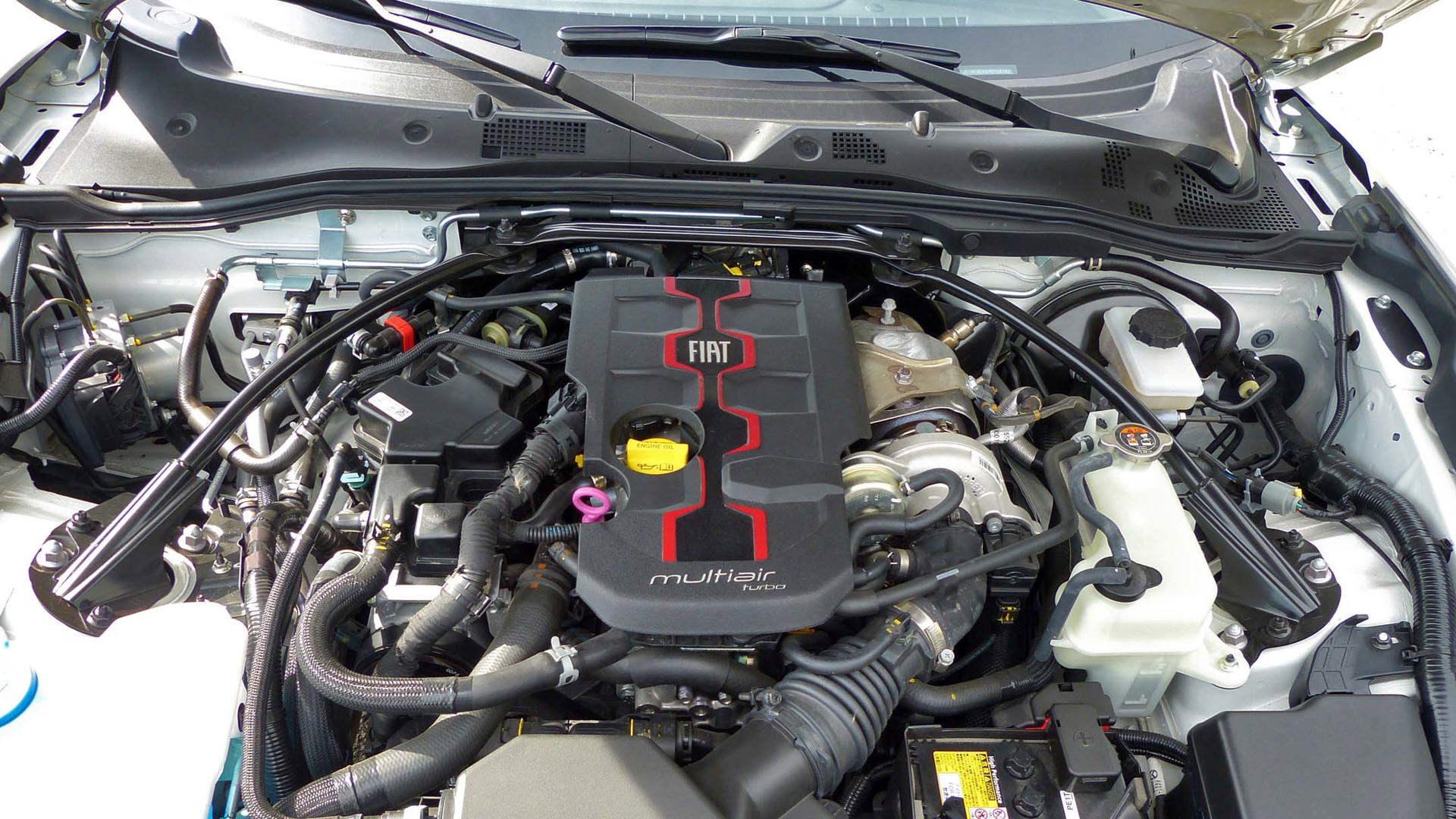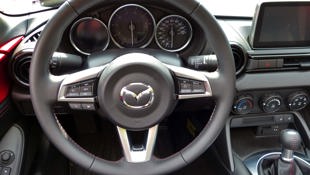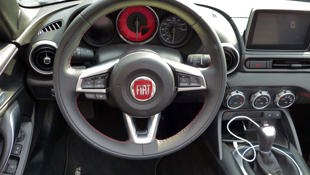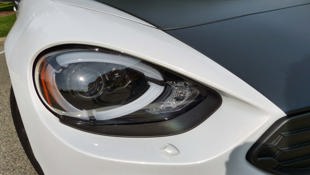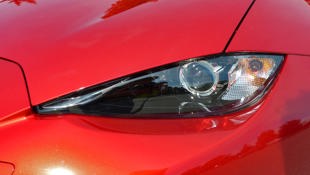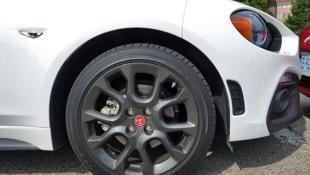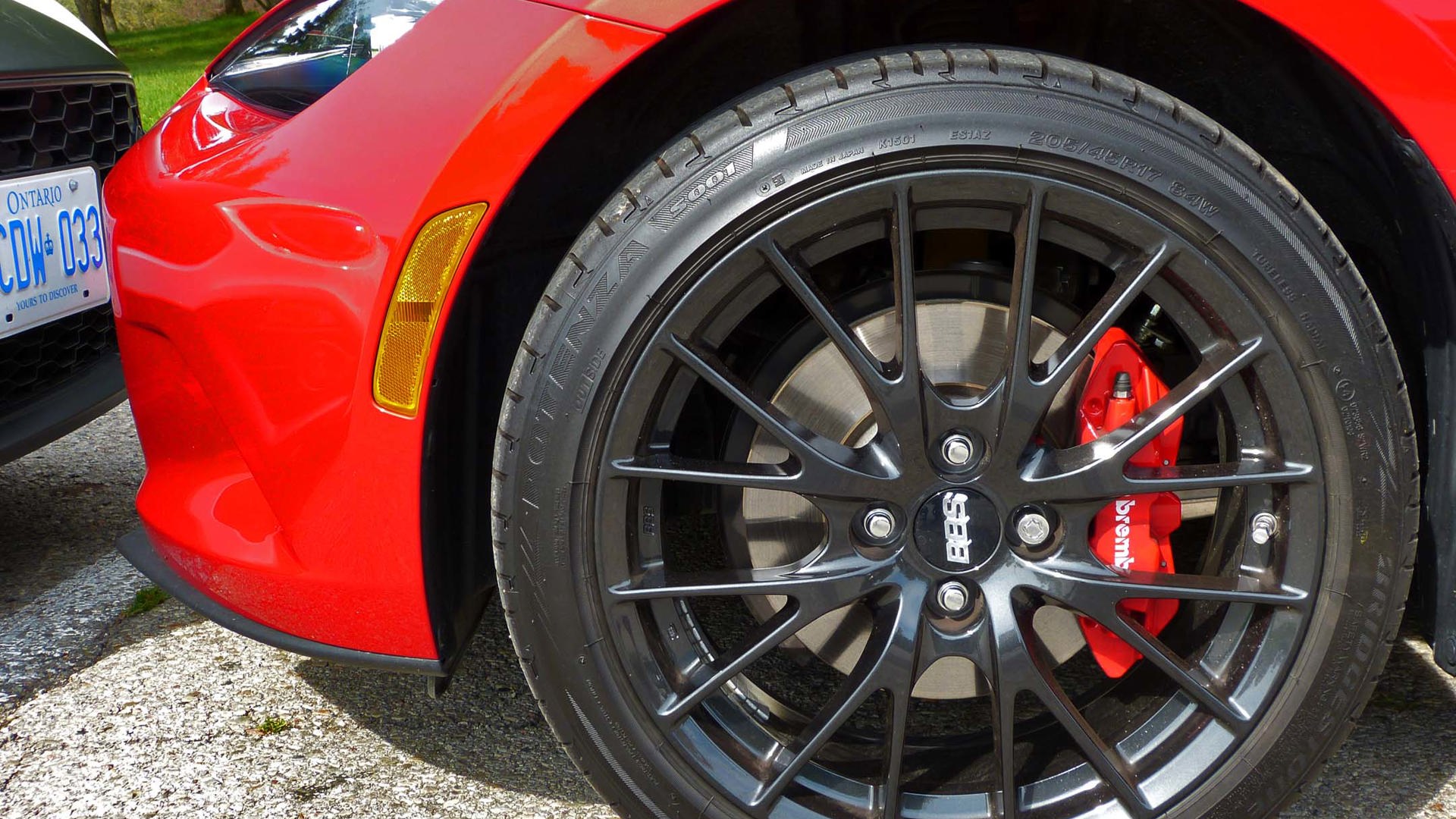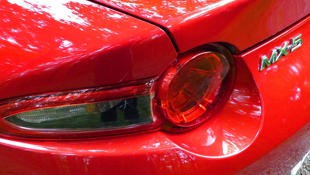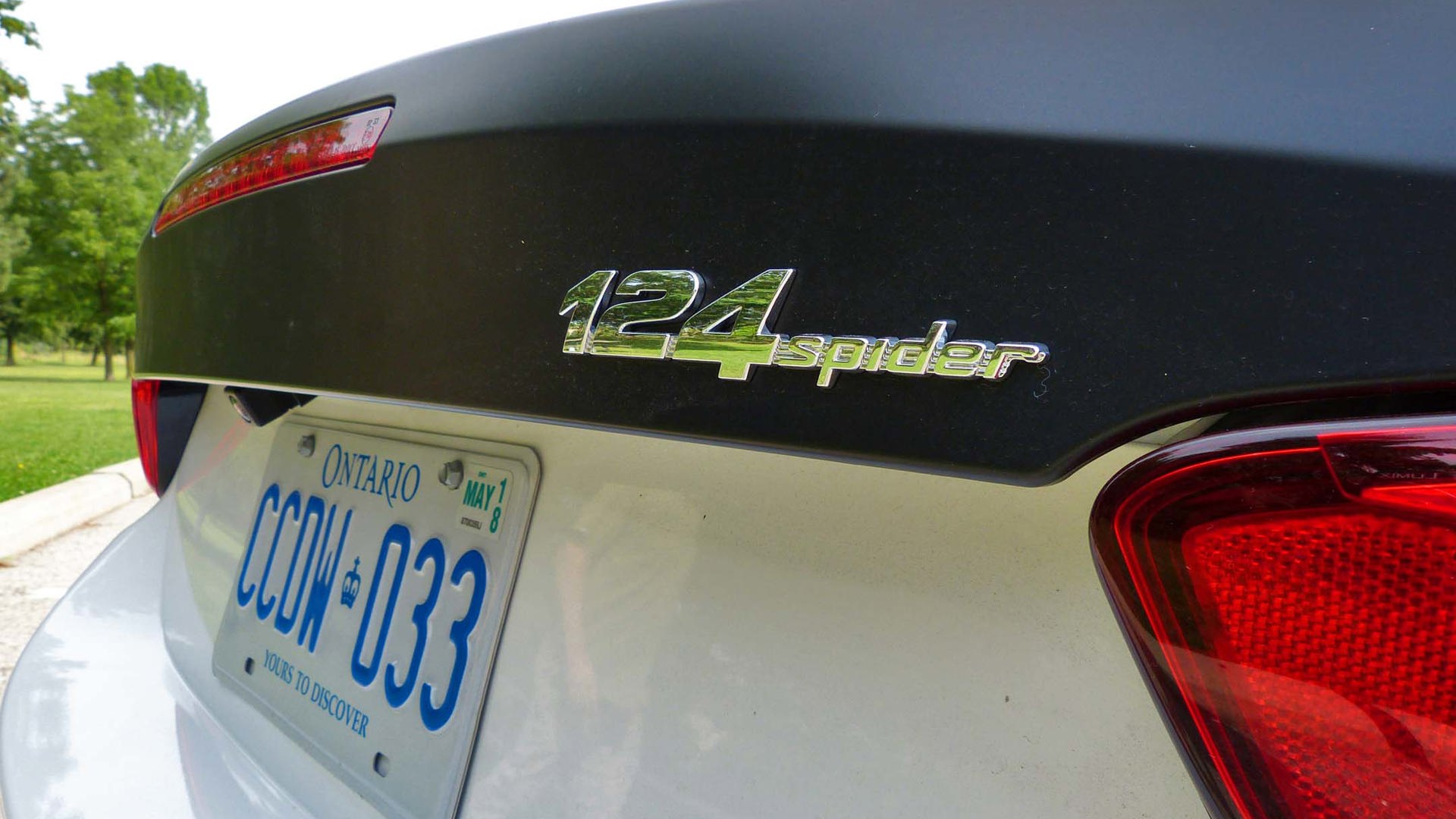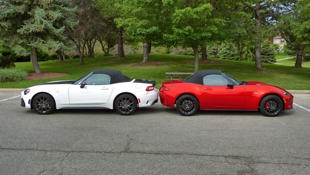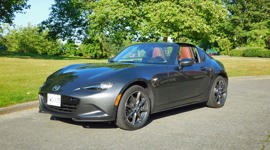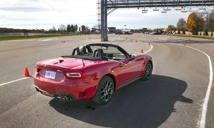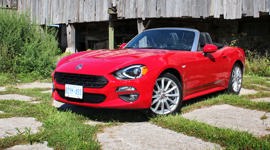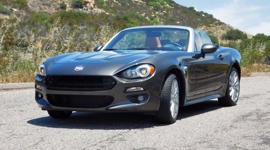Comparison Data
|
2017 Fiat 124 Spider Abarth
|
2017 Mazda MX-5 GS Sport Package
|
|---|---|
|
Engine Displacement
1.4L
|
2.0L
|
|
Engine Cylinders
I4
|
I4
|
|
Peak Horsepower
164 hp
|
155 hp @ 6,000 rpm
|
|
Peak Torque
184 lb-ft @ 4,600 rpm
|
148 lb-ft @ 4,600 rpm
|
|
Fuel Economy
9.0/6.7/7.9 L/100 km cty/hwy/cmb
|
8.9/7.1/8.1 L/100 km cty/hwy/cmb
|
|
Cargo Space
139 L
|
130 L
|
|
Base Price
$37,995
|
$35,800
|
|
A/C Tax
$100
|
$100
|
|
Destination Fee
$1,795
|
$1,795
|
|
Price as Tested
$49,380
|
$42,395
|
|
Optional Equipment
$9,490 – Bianca-Perla Tri-Coat paint, $995; Luxury Collection, $5,500; Hand-painted Heritage Racing Stripe, $2,995
|
$4,700 – Sport Package (17-inch BBS forged wheels (dark finish), Brembo front brakes (opposed piston design/unique rotor), red painted front and rear brake calipers, Recaro sport seats (heated seats trimmed with leather and Alcantara)), $4,400; Soul Red Metallic exterior colour, $300
|
To say that the agilely adorable 2017 Mazda MX-5 GS and the adorably agile 2017 Fiat 124 Spider Abarth are similar is an understatement bordering on fake news. These two roadsters are built on the same platform in the same factory in Hiroshima, Japan, and share many identical measurements and accoutrements starting with their easy-to-open/close soft tops.
If the Mazda is Goldilocks, the Fiat is a panel of experts.
It’s hard to choose. My co-tester, Jacob Black likens them to twins he knew in high school: “They were 90 percent identical, yet one of them got a lot of love from some sections of the community, the other from another section. I couldn’t split the difference myself. These cars are those twins.”
Using a similar analogy, I thought of this pair as Archie Comics’ Betty and Veronica, who had the same face and body but different hair and marketing. Like Jacob, I have trouble choosing a favourite.
What matters is not which hot twin you’re loving but which community you, the twin lover, inhabit. Do you prefer Betty or Veronica’s personality? Stumped, Jacob and I must now nitpick differences and hope for a definitive winner.
The powertrains: at least they’re different
The Fiat is powered by 1.4L MultiAir turbo four-cylinder engine that achieves 164 hp plus 184 lb-ft of torque and is matched to a six-speed manual transmission. The Mazda also contains a four-cylinder engine but it’s a 2.0L and naturally aspirated. That unit puts out a less-powerful maximum 155 hp and just 148 ft-lb of torque. So power advantage Fiat, technically.
But engine capability is only one (albeit key) piece of the puzzle. How heavy you are co-dictates how efficient your engine can be. Ever notice how skinny elite race drivers are? They have more in common with jockeys than the hobbyist racers I know.
The Mazda weighs 1,078 kg while the Fiat is a slightly more muscular 1,124. That’s a mere 46 kg (101.4 lb).
So one twin from Jacob’s high school wore leather jackets and biker boots, the other yoga gear and sandals. Nonetheless, that is a genuine power difference. Note the Fiat Spider’s throatier guttural growl. Jacob mused, “If you’re one of those people who wants the MX-5 to be turbocharged and have more power, then voila, Fiat has you covered. The engine sounds better, pulls a little harder... if you were going to tune your roadster, the 124 is the one with more tuneability.
“Still, Fiat has missed an opportunity here to put serious space between itself and Mazda – the 124 carries the Abarth name, but not the raucous exhaust. This is a big shame.”
For those about shift, we salute you – for now
The manufacturers of each car offer the option of a six-speed automatic transmission with paddle shifters. Yes, you can pay more to switch either of these sweet gearboxes for an automatic transmission to make driving less challenging. There was a time, not long ago, that I’d say you could also jab an ice pick in your eye to render an out-of-control world less complicated – or: rather than searching out and marrying an ideal life partner that you could stay at home and just look at dirty pictures online all day – but change is inevitable and stick-shifters are gradually disappearing.
So let’s all just enjoy these fading days of traditional manual shifting.
Mind, if you were raised on computer tech instead of pinball and are uncomfortable with having to “feel” when to shift, the Mazda comes with MyFirstStickShift™. This feature helpfully suggests when to gear up and down with numerical onscreen prompts. Advantage Mazda? Thankfully, you don’t have to pay attention to it. It feeds real-time data to your dial. So you can shift when you damn well please!
The Fiat does not include this feature, so you can shift when you damn well please as well but without the mental nagging or Catholic guilt. Advantage Fiat!
As for which transmission feels better to shift, that comes down to your Betty/Veronica preference. Jacob: “The Fiat runs the previous-gen Mazda gearbox in it, and its notchy, firm feel will appeal to some who like that heft.”
Notchy is a good invented word. Shifting feels substantial in the Fiat, what I’ve called chunky. Driving enthusiasts will love it. On the other hand, the Mazda is smooth and incredibly easy – forgiving – making that abhorrent MyFirstStickShift feature unnecessary.
However both Jacob and I noticed that gearing up and down in the Mazda is “effortless without losing feel.” You barely notice it. My wife, too, who rarely uses stick shifts these days, was impressed with how neatly the gears fell into place. Mazda has had that many more years to tinker and produce a holistic driving experience. It’s the Goldilocks effect: just right.
Maybe, rather than Archie girls, it’s more of a peanut butter comparison: are you a chunky or smooth spreader?
So close, even the fuel-efficiency numbers deserve context
This entire drive experiment took a day. Before and after, Jacob had the Spider for a week and I had the MX-5. So during our three-hour head-to-head test, we switched. He led the drive, politely signaling turns out of the suburbs and into the nearby country.
Our fuel-efficiency numbers, after a drive that included minimal city driving but plenty of major highways and a confection of twisty, turny country byways, were: 6.6 L/100 km in the leader’s Mazda and 7.6 in the follower’s Fiat. Both cars were riding on 17-inch wheels, upgraded from base trim 16-inch.
However it’s worth observing that a follower struggling to tail any driver in busy traffic tends to burn more fuel, just as a leader trying to keep someone in his rear-view mirror could burn less.
Which is the better drive? We love all our children
Few Canadians think of the Southern Ontario as having pretty scenery. However the Niagara Escarpment is a UNESCO World Biosphere Reserve. The Forks of the Credit is an especially dramatic corner of the Escarpment, slightly more than an hour’s drive from downtown Toronto (at legal speeds and provided you don’t have workaday Toronto traffic).
The secret got out decades ago what fun this area’s hills and turns are for drivers, including a couple of switchbacks that could have been dropped in from British Columbia – or French Switzerland for that matter. It’s a great spot to test any vehicle, but especially two such roadsters that purport agility and grip.
This area is also a leafy haunt of the horsey rich, so police regularly stake out and ticket speeders. Other times, impressively tall speed bumps can cost aggressive drivers just as much money but without adding insurance points. The lead-ups to these bumps are good spots to test brakes that purport sport tuning.
Enter Jacob and Steven in the Mazda MX-5 GS and Fiat 124 Spider Abarth. Both of these roadsters feature rear-wheel drive: advantage driver.
How stumped were we for a favourite? Much. The differences are really hard to quantify. For example, the turning diameter of the Fiat is an exciting 9.4 m, curb to curb, compared to the Mazda’s 9.4 m, kerb to kerb.
Betty and Veronica had the same face and body.
The Fiat Spider has a sport mode, which is only barely noticeable. The Mazda doesn’t bother; you’d never choose anything else. The steering of the Spider has an exciting meaty heft that, again, many driving enthusiasts will gush over. The MX-5 is lighter in feel yet somehow sacrifices zero nimbularity [Another “good invented word”? – Ed.]. You blend into the car, like steering, shifting and braking are all one function.
If the Mazda is Goldilocks, the Fiat is a panel of experts. Overall I liked the unity of the Mazda and the driving components of the Fiat. Jacob summarized the drives neatly: “more composure in the Fiat, more agility in the Mazda.”
Design’s in the eye the beholder
The difference is in the marketing. The Fiat is sportier with its blackened hood and hallmark scorpion Abarth badges. It says, “I’m wicked.” The Mazda is more classic and incongruently evokes Riviera nostalgia better than the “Italian”. Its red metallic panels in the inner doors bring the outside into this convertible before you’ve even lowered the roof. It says, “I’m naughty.”
The seats in each car were excellent for position and support but we both preferred the Mazda slightly. Its brushed-suede-like cloth seats with red stitching looked and felt lovelier than even the rich leather of the Fiat. Advantage Mazda. But spill one flavoured coffee in the MX-5 and that advantage becomes questionable. It’s a small car, especially with the roof down.
The length and width measurements between the two are negligible enough that you need to study whether license plate holders and rear-view mirrors are included to establish genuine differences.
The height of the two cars is also almost identical to the very millimetre but Jacob observed “less wind noise and buffeting” in the Fiat. However this Spider tester’ Luxury Collection package pampers riders with a nine-speaker Bose sound system with Sirius XM. (The same in the MX-5 would require an upgrade to the GT trim.) So perhaps, maybe and possibly, it just sounded better because it sounded better – and our and your final decision comes down to the extras.
Dollars for goodies: advantage Mazda, then again...
The MX-5 doesn’t include a rear-view camera. Of course you don’t need it. The Spider has a sport button. Of course you don’t notice it.
A quick gander at the as-driven prices briefly affects my decision: $49,380 for the Fiat and $42,395 for the Mazda. But look closer: the Spider just docked you almost three large for a “hand-painted heritage racing stripe”. Let’s assume you aren’t overburdened with a need to respect tradition; suddenly you’re down to a more comparable $46,675. It’s still more expensive but it’s not like the difference between Veronica’s mansion and Betty’s house. It’s more like hot twins.
Jacob Takes the Bullet
Poor Steven seems stuck on the fence, so let me be blunt. The MX-5 is in this comparison test a clear winner. Even if there was no other reason to give, the $7,000 difference in as-tested prices is enough to cement the crown for the Mazda.
But a bigger, and arguably better, reason, is that FCA missed its opportunity to properly differentiate itself. What MX-5 critics have long sort after is a raucous, turbocharged engine. Something vicious enough to overwhelm the rear tires and assault the ear drums. Fiat has such abilities, and could have bought more firepower to the party – that would have netted a different result.
It would be nearly impossible to beat out the Mazda for balance – so Fiat’s move should have been an almighty sledgehammer in the engine bay.
For now though, because the balance is better and because the price is better, the Mazda MX-5 gets the nod.

